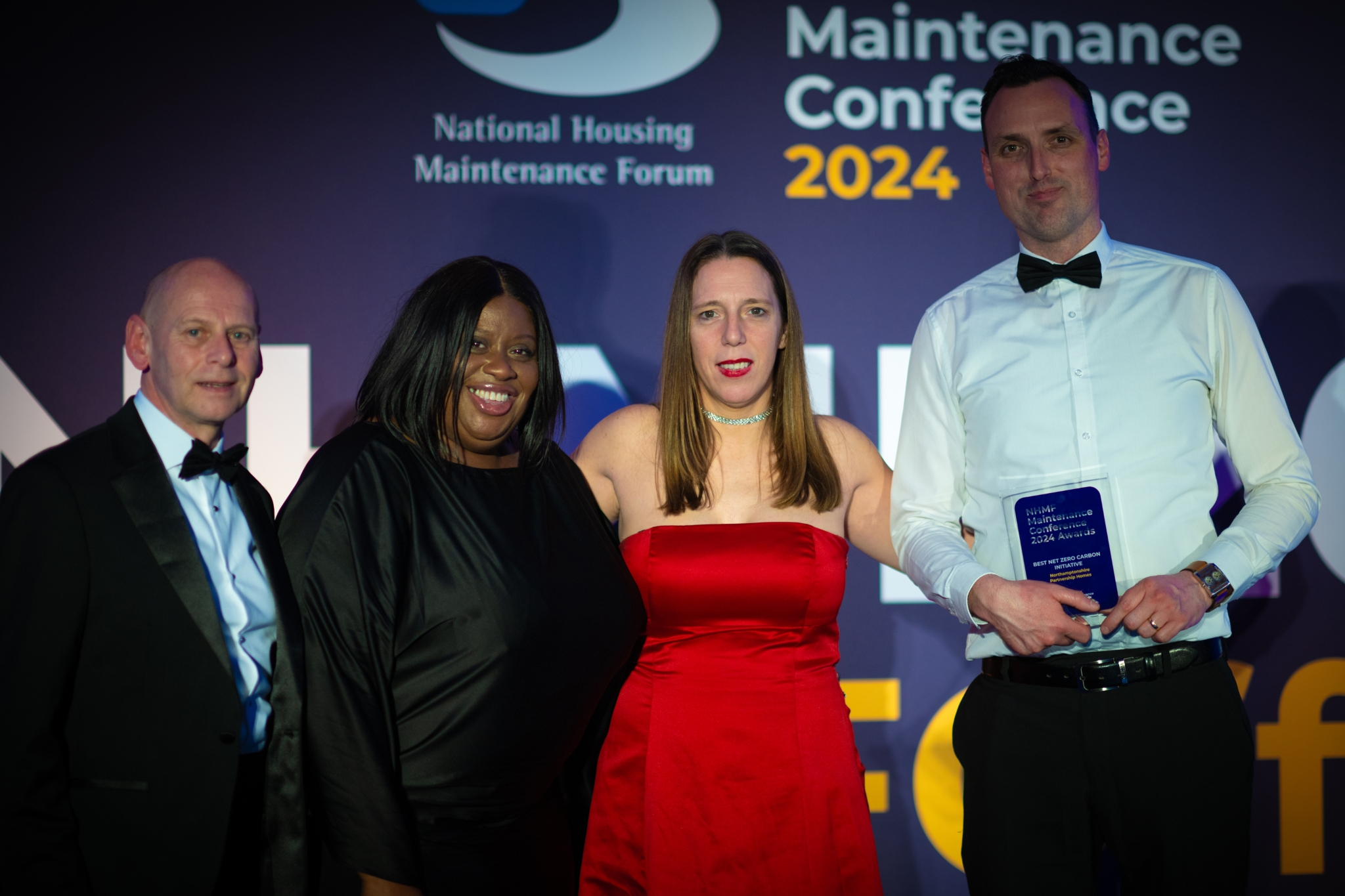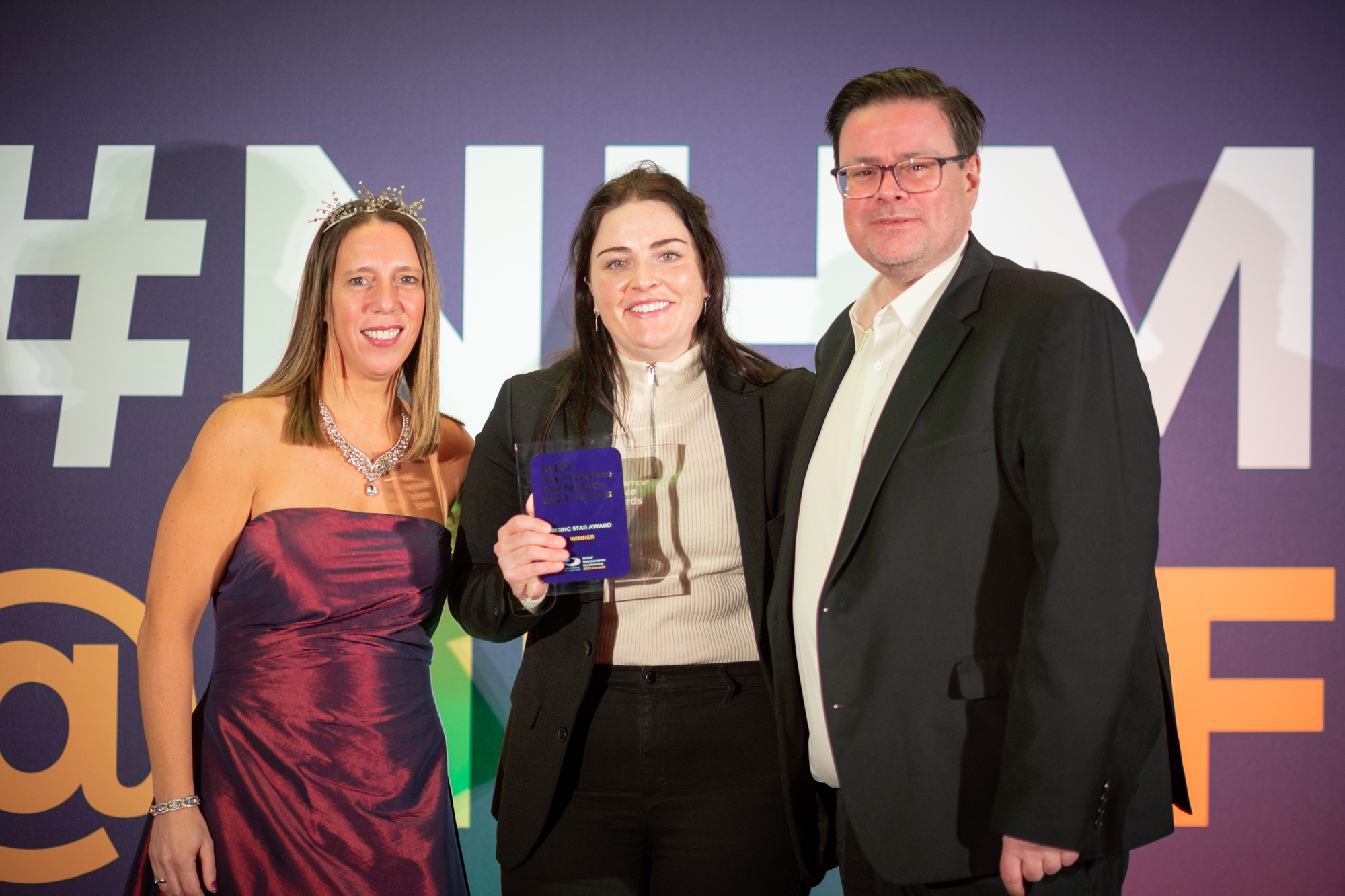NHMF Awards 2024 Best Net Zero Carbon Initiative Winner: Northamptonshire Partnership Homes
Shortlisters: LiveWest & Ian Williams | Northern Ireland Housing Executive (NIHE)

Every year, we publish a summary of all our shortlisted entries to showcase our amazing nominees and promote best practice across the sector.
You can read more about the NHMF Awards here.
Winner: Northamptonshire Partnership Homes
Other shortlisted schemes (see Appendix)
Northern Ireland Housing Executive (NIHE)
Achievements
Northamptonshire Partnership Homes (NPH) made good use of the technology with SHDF PAS2035 Digital Design, the Retrofit Designers implemented an innovative scan to BIM (IoT) devices, monitoring performance post retrofit (involved pre, during and post works), linking environmental safety monitoring to fire safety systems. Dealing with solid walled properties is not easy thing but NPH innovated with more BIM and sensors than PAS2035 requires. The next stage is larger scale and hard to reach properties, using the same design considerations incl. M&E and being Heat pump ready. There were 3 key innovations: Digital Design Our Retrofit Designers, Constructive Thinking Studios (CTS), innovative scan to BIM workflow approach (a digital process using BIM/BEM, LIDAR, SAP).
What was the project and what was innovative about the service provided?
NPH’s Whole House Retrofit Programme, funded by SHDF Wave 1, completed February 2024, successfully retrofitted 429 pre-war solid wall homes in Northampton, installed external wall insulation, loft insulation top-up, new windows and doors, and mechanical ventilation. In 2021-22, NPH completed its award winning SHDF demonstrator project to complete deep retrofit to 150 homes. High standards had been achieved, following the PAS 2035 framework, but it had been at a high cost and had taken two years from start to finish. At that rate, it would take 160 years to retrofit the stock of c12,000 council homes NPH manage. That would be too long! The Wave 1 project almost tripled the delivery ambition, scaling up to complete 429 retrofits. Scaling up retrofit is a hugely important challenge for the housing sector. To achieve local and national net zero carbon ambitions, innovation is essential to make retrofit more cost effective, and to greatly increase the scale of delivery. Innovation themes included: Digital Design – Our Retrofit Designers implemented an innovative scan to BIM workflow which connected the PAS 2035 process through assessment, design, and delivery. Off-site Manufacturing – an off-site solution to bay window roofs was identified by the Contractors and the project team worked together to reach the right specification for thermal performance, fire-resistance, and sequencing of installation. Internet of Things – The project developed NPH’s use of ‘Internet of Things’ (IoT) devices, monitoring performance post retrofit, linking environmental safety monitoring to fire safety systems.
What were the measurable benefits to the client, the contractor, the resident, and the neighbourhood?
NPH’s project has been a significant boost to its ambitions for transforming to a net zero carbon housing stock, transforming what were some of the least energy efficient homes to ‘heat pump ready.’ NPH are committed to ensuring its entire housing stock is EPC Band C or better before 2030. Pre-retrofit, the 429 homes were starting at EPC band D to E, and with an average space heating demand of approximately 200 kWh/m2. Post retrofit, the homes have been improved to at least EPC Band C, eliminating fuel poverty according to the governments LILEE metric. Space heating demand has reduced by 70% to an average 58 kWh/m2, exceeding the SHDF Wave 1 target of 90 kWh/m2. Based on SAP modelling, NHP can expect the cost to heat these homes to a comfortable level to have reduced by as much as half. NPH worked closely with principal contractors and consultants, including Retrofit Designers and Retrofit Coordinators, to develop a successful fabric first approach to deep retrofit that could be replicated across the sector. The project has been delivered with a collaborative approach to continual learning across contractor and consultant relationships, helping all stakeholders to develop delivery approaches and identify best practice and learning opportunities. The Wave 1 project put into practice everything that had been learned from the demonstrator and continues to be an incredible learning experience for NPH and its contractors and consultants. The increased scale added complexity to tasks such as resident engagement, project management, and Trustmark administration. Mid-way through the project a lessons learned workshop was held with contractor and design teams to address challenges and acknowledge successes. From demo to Wave 1 and now into Wave 2, retrofit has provided NPH with cyclical learning opportunities to continue to develop their delivery model. Residents have benefitted from reduced risk of fuel poverty and damp and mould. The selected homes were targeted for the project due to the prevailing solid wall construction types in these neighbourhoods. Solid wall archetypes were poorly insulated, prone to damp and mould, putting households, typically families or elderly residents, at risk of fuel poverty. All upgrades greatly reduced the risk of damp and mould, creating safer, healthier living environments, and better homes. By insulating the external walls, they will be less cold in winter meaning condensation is less likely to form. Without moisture, mould is less prevalent. Fundamental building issues such as structural issues, failing brickwork or rainwater goods have been identified and remedied, resulting in homes much less likely to take in moisture from the outside. Ventilation has also been improved or maintained. At a neighbourhood level, the project represented regeneration of areas in the lowest percentiles of the Index of Multiple Deprivation (IMD). The retrofits focused on terraced and semi-detached housing, and low-rise flats. These areas have been transformed with a modernised façade, improving the aesthetics of the areas, and providing inspiration for private rental sector and owner occupier.
What were the financial costs and measurable cashable benefits over a defined time period?
NPH secured £6.1m of grant funding from the SHDF Wave 1, with a £10m match funding contribution by NPH for this circa £16m project. The project began in January 2022, started onsite in Spring 2022, and completed February 2024. Pre-retrofit, all homes were EPC band D or worse, with an average SAP score of 62. Post retrofit, the homes are now at least EPC Band C, and have improved to an average score of 77. The biggest improvement was a 42-point uplift from SAP 35 (EPC F) to 77 (EPC C). Best output was SAP 81 (EPC B). Based on SAP modelling, NPH expect the cost to heat the homes to a comfortable level to be reduced by around half. Space heating demand (SHD) is a key performance indicator under SHDF, with a target to reduce SHD to no greater than 90 kWh/m2/yr. The average SHD pre-retrofit was roughly 200 kWh/m2/yr. Post-retrofit the average SHD is reduced by roughly 70% to 58 kWh/m2/yr., with the best performing homes as low as 33 kWh/m2/yr. For context, the SHD of an average UK home is 145 kWh/m2/yr. and a new build home about 50 kWh/m2/yr., so for homes that are almost 100 years old, the performance is extremely good.
How relevant is this as an example that might be followed by other organisations?
NPH’s retrofit approach has been explicitly fabric-first, based on their experience that some social housing households simply can’t afford to heat the home to comfortable levels, and some don’t heat the home at all. Focusing on minimising heat loss rather than heating technology is the approach that gives the greatest impact for short term comfort, and longer term thinking towards a net zero carbon housing stock. Feedback from tenants is that “Since insulation, once the house is heated it stays warmer longer.” The retrofits were delivered following PAS 2035 as a framework for best practice and risk management. Alternative contractual arrangements for the various PAS 2035 roles and responsibilities have been trialled, settling on a procurement approach which decouples the Retrofit Designer from the Principal Contractor. In our experience as client, a strong relationship with Retrofit Designer and Retrofit Coordinator has been extremely important to ensure PAS 2035 works for our benefit. Three key innovations have been developed through this project: Digital Design– Our Retrofit Designers, Constructive Thinking Studios, implemented an innovative scan to BIM workflow approach enabling energy modelling and working drawings to be developed efficiently and amended on the fly. A digital process using BIM/BEM, LIDAR, SAP, and other software, connected the PAS 2035 process through assessment, design and delivery. Retrofit is prone to throwing up surprises, and 3D digital models aided collaboration and efficiency identifying constraints and enabling works onsite. Off-site Manufacturing – Approximately 50 homes in the project had bay window roofs requiring special care and attention. Speed of changing the bay windows was vital to resident comfort and experience; the aim was to complete within one day. An off-site solution was identified by the Contractor, and the project team worked together to reach the right specification for the thermal performance and fire-resistance. The site teams ensured the correct sequencing whilst awaiting the EWI installation after the bays were installed, demonstrating teamwork, innovation, coordination, sequencing, and care for resident wellbeing and experience. Internet of Things (IoT) – The project developed NPHs use of IoT devices, monitoring performance post retrofit. NPH chose to install Aico HomeLINK devices in every home. The system links environmental safety monitoring to fire safety systems, integrating into existing systems used by NPH. The IoT devices monitor temperature, relative humidity, and CO2, providing proxies for a variety of risks including fuel poverty, and damp and mould. Installing IoT monitoring into each home provides a proactive tool for assessing internal conditions post-retrofit, and a prototype for wider adoption of monitoring across NPH housing stock, particularly for damp and mould.
Appendix: Download our shortlisted apprentices’ submissions below.


